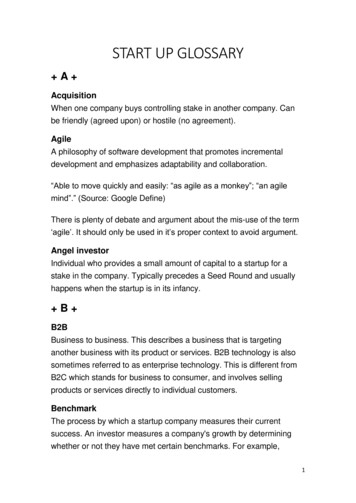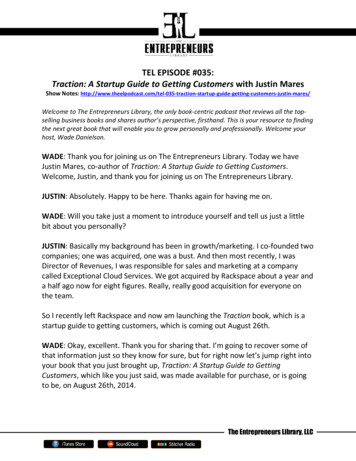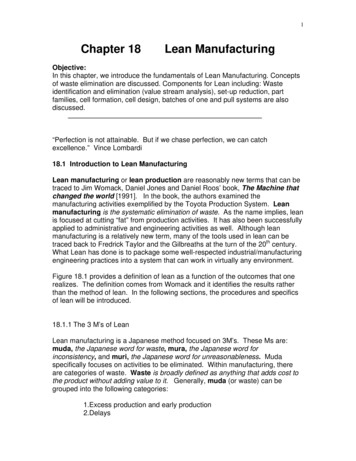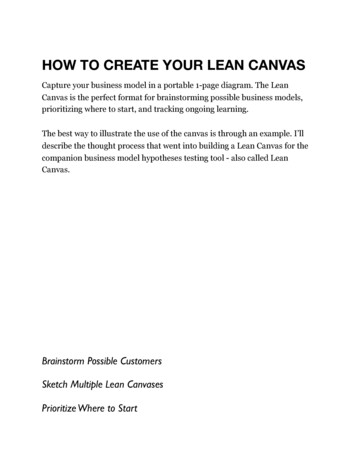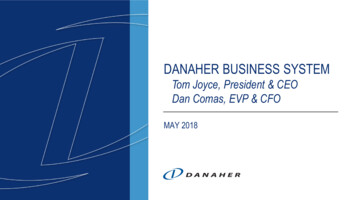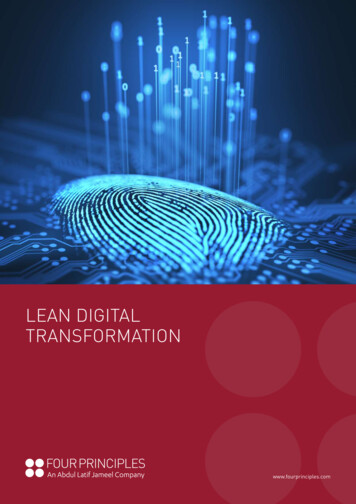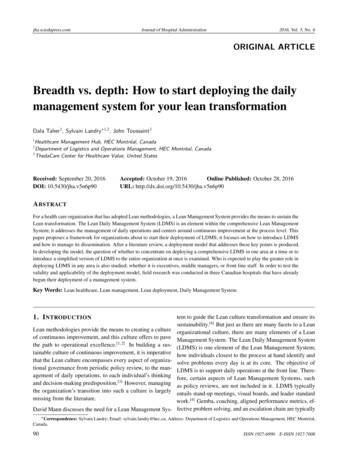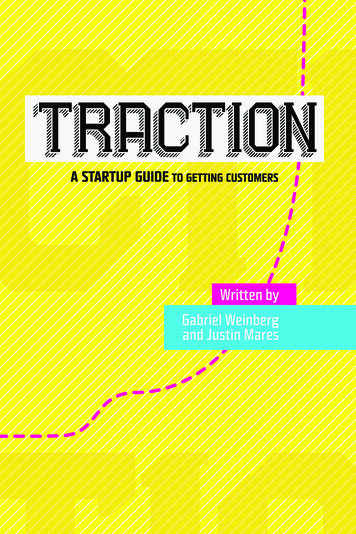
Transcription
TractionA STARTUP GUIDETO GETTING CUSTOMERSGabriel Weinberg and Justin Mares
2014 by Gabriel Weinberg and Justin MaresAll rights reservedS-curves PublishingPrinted in the United States of AmericaFirst edition, HardcoverISBN 978-0976339601
Table of Contents1 2 3 4 5 6 7 8 9 10 11 12 13 14 15 16 17 18 19 20 21 22 23 24 25 ProloguevTraction Channels1The Bullseye Framework9Traction Thinking19Traction Testing31Critical Path39Viral Marketing49Public Relations (PR)63Unconventional PR73Search Engine Marketing85Social & Display Ads97Offline Ads109Search Engine Optimization121Content Marketing133Email Marketing141Engineering As Marketing151Targeting Blogs161Business Development169Sales181Affiliate Programs195Existing Platforms205Trade Shows215Offline Events223Speaking Engagements233Community Building241Afterword249
PROLOGUETraction Trumps EverythingBuilding a successful company is hard. Really hard. We’ve been involved in both startup successes and startup failures.Who are we? Gabriel is currently the CEO and founder of DuckDuckGo, an alternative search engine he started in 2008 that received overa billion searches in 2013 and is growing rapidly. In 2006, he sold hislast company, Opobox, for ten million. Gabriel is also an active angelinvestor, having invested in over ten early stage ventures with two successful exits so far.Justin founded two startups (one of which was acquired) and recently ran growth at Exceptional Cloud Services, which was acquired byRackspace in 2013.Traction is the best way to improve your chances of startup success.Traction is a sign that something is working. If you charge for yourproduct, it means customers are buying. If your product is free, it’s agrowing userbase.Traction is powerful. Technical, market, and team risks are easier toaddress with traction. Fundraising, hiring, press, partnerships and acquisitions are all easier with traction.In other words, traction trumps everything.This book is for startups of all kinds: consumer or enterprise-focused,from ecommerce to apps and everything in between.
TRACTION A STARTUP GUIDE TO GETTING CUSTOMERSWe’ve interviewed more than forty founders, studied many morecompanies, and pulled out the repeatable strategies and tactics theyused to succeed.Our goal is to show you how to get traction no matter what businessyou’re in.
CHAPTER 1Traction ChannelsBefore we get started, let’s define what traction is. Traction is a signthat your company is taking off. It’s obvious in your core metrics:if you have a mobile app, your download rate is growing rapidly. Ifyou’re a search engine, your number of searches is skyrocketing. If aSaaS tool, your monthly revenue is blowing up. If a consumer app,your daily active users are increasing quickly. You get the point.Naval Ravikant, founder of AngelList, an online platform thathelps companies raise money, says it well:“Traction is basically quantitative evidence of customer demand. So ifyou’re in enterprise software, [initial traction] may be two or three early customers who are paying a bit; if you’re in consumer software thebar might be as high as hundreds of thousands of users. It’s the Supreme Court definition of porn. You’ll know it when you see it.”You can always get more traction. The whole point of a startupis to grow rapidly. Getting traction means moving your growthcurve up and to the right as best you can. Paul Graham, founder of startup accelerator Y Combinator, puts it like this:“A startup is a company designed to grow fast. Being newly founded doesnot in itself make a company a startup. Nor is it necessary for a startupto work on technology, or take venture funding, or have some sort of‘exit.’ The only essential thing is growth. Everything else we associate withstartups follows from growth.”
CHAPTER 1 TRACTION CHANNELS2In other words, traction is growth. The pursuit of traction is whatdefines a startup.Nineteen Traction ChannelsAfter interviewing more than forty successful founders and researching countless more, we discovered that startups get traction throughnineteen different channels. Many successful startups experimentedwith multiple channels (search engine marketing, business development, etc.) until they found one that worked.We call these customer acquisition channels traction channels.These are marketing and distribution channels through whichyour startup can get traction: real users and customers.We discovered two broad themes through our research:1. Most founders only consider using traction channels they’realready familiar with or think they should be using becauseof their type of product or company. This means that far toomany startups focus on the same channels (search enginemarketing, public relations) and ignore other promising waysto get traction.2. It’s hard to predict the channel that will work best. You canmake educated guesses, but until you start running tests,it’s difficult to tell which channel is the best one for youright now.Our introductory chapters 2–5 expand on these themes. Chapter 2introduces our Bullseye Framework for getting traction. Essentially, it involves targeted experimentation with a few traction channels,followed by laser focus on the one that is working.
CHAPTER 1 TRACTION CHANNELS3Chapters 3 and 4 offer traction strategies and tactics to apply when using Bullseye, including pursuing traction development in parallel withproduct development. Chapter 5 offers one way to approach paralleltraction/product development – called the Critical Path – where youfocus on a single traction goal and ignore everything not required toachieve it.Before you jump into this material, however, we’d like to introduce you to the nineteen traction channels and some of the peoplewe interviewed for them. We will explore each of these channels inchapters 6–24.When going through these traction channels try your best not to dismiss them as irrelevant for your company. Each traction channel hasworked for startups of all kinds and in all different stages. Get onechannel working that your competitors dismiss, and you can growrapidly while they languish.Viral Marketing (Chapter 6)Viral marketing consists of growing your userbase by encouragingyour users to refer other users. We interviewed Andrew Chen, a viralmarketing expert and mentor at 500 Startups, for common viral techniques and the factors that have led to viral adoption in major startups.We also talked with Ashish Kundra of myZamana, who discussed using viral marketing to grow from 100k users to over 4 million in lessthan a year.Public Relations (Chapter 7)Public relations (PR) is the art of getting your name out there via traditional media outlets like newspapers, magazines and TV. We interviewed Jason Kincaid, former TechCrunch writer, about pitching media outlets, how to form relationships with reporters, and what moststartups do wrong when it comes to PR. We also talked with RyanHoliday, bestselling author of Trust Me, I’m Lying and media strategist,to learn how startups could leverage today’s rapidly changing medialandscape to get traction.
CHAPTER 1 TRACTION CHANNELS4Unconventional PR (Chapter 8)Unconventional PR involves doing something exceptional (like publicity stunts) to draw media attention. This channel can also work byrepeatedly going above and beyond for your customers. Alexis Ohanian told us some of the things he did to get (and keep) people talkingabout reddit and Hipmunk, two startups he co-founded.Search Engine Marketing (Chapter 9)Search engine marketing (SEM) allows companies to advertise to consumers searching on Google and other search engines. We interviewedMatthew Monahan of Inflection, the company behind Archives.com(before its 100 million acquisition by Ancestry.com) to learn how Archives relied primarily on SEM for their growth.Social and Display Ads (Chapter 10)Ads on popular sites like reddit, YouTube, Facebook, Twitter and hundreds of other niche sites can be a powerful and scalable way to reachnew customers. We brought in Nikhil Sethi, founder of the social adbuying platform Adaptly, to talk with us about getting traction withsocial and display ads.Offline Ads (Chapter 11)Offline ads include TV spots, radio commercials, billboards, infomercials, newspaper and magazine ads, as well as flyers and other localadvertisements. These ads reach demographics that are harder to target online, like seniors, less tech-savvy consumers and commuters.Few startups use this channel, which means there’s less competitionfor many of these audiences. We talked with Jason Cohen, founder ofWPEngine and Smart Bear Software, about the offline ads he’s used toacquire customers.Search Engine Optimization (Chapter 12)Search engine optimization (SEO) is the process of makingsure your website shows up for key search results. We interviewed Rand Fishkin of Moz (the market leader in SEO software) to talk about best practices for getting traction with SEO.
CHAPTER 1 TRACTION CHANNELS5Patrick McKenzie, founder of Appointment Reminder, also explainedto us how he uses SEO to cheaply acquire lots of highly targeted traffic.Content Marketing (Chapter 13)Many startups have blogs. However, most don’t use their blogs to gettraction. We talked with Rick Perreault, founder of Unbounce, andOkCupid founder Sam Yagan to learn how their blogs transformedtheir businesses.Email Marketing (Chapter 14)Email marketing is one of the best ways to convert prospects while retaining and monetizing existing ones. For this chapter we interviewedColin Nederkoorn, founder of email marketing startup Customer.io,to discuss how startups can get the most out this traction channel.Engineering as Marketing (Chapter 15)Using engineering resources to acquire customers is an underutilized way to get traction. Successful companies have built micro-sites,developed widgets, and created free tools that drive thousands ofleads each month. We asked Dharmesh Shah, founder of Hubspot,to discuss how engineering as marketing has driven Hubspot’s growthto tens of thousands of customers through tools like their Marketing Grader.Targeting Blogs (Chapter 16)Popular startups like Codecademy, Mint, and reddit all got their startby targeting blogs. Noah Kagan, Mint’s former director of marketing,told us how he targeted niche blogs early on, and how this strategyallowed Mint to acquire 40,000 users before launching.Business Development (Chapter 17)Business development (BD) is the process of creating strategicrelationships that benefit both your startup and your partner.Paul English, co-founder and CEO of Kayak.com, walked us throughthe impact of their early partnership with AOL. We also interviewedventure capitalist Chris Fralic, whose BD efforts at Half.com werea major factor in eBay’s 350 million acquisition of the company.
CHAPTER 1 TRACTION CHANNELS6We’ll show you how to structure deals, find strategic partners, build abusiness development pipeline, and approach potential partners.Sales (Chapter 18)Sales is primarily focused on creating processes to directly exchangeproduct for dollars. We interviewed David Skok of Matrix Partners– someone who’s taken four different companies public – to get hisperspective on how the best software companies are creating sustainable, scalable sales processes. We also take a look at how to find earlycustomers and have winning sales conversations.Affiliate Programs (Chapter 19)Companies like Hostgator, GoDaddy and Sprout Social have robustaffiliate programs that have allowed them to reach hundreds of thousands of customers in a cost-effective way. We interviewed KristopherJones, founder of the Pepperjam Affiliate network, to learn how astartup can leverage this channel. We also talked with Maneesh Sethito learn how affiliate marketers choose what products to promote, andsome of the strategies they use to do so.Existing Platforms (Chapter 20)Focusing on existing platforms means focusing your growth efforts ona mega-platform like Facebook, Twitter, or an App Store and gettingsome of their hundreds of millions of users to use your product. AlexPachikov, co-founder of Evernote, explained how their focus on Apple’s App Store generated millions of customers.Trade Shows (Chapter 21)Trade shows are a chance for companies in specific industries to showoff their latest products. We interviewed Brian Riley of SlidePad, aninnovative bike brake startup, to learn how they sealed a partnershipthat led to over 20,000 sales from one trade show and their approachto getting traction at each event.
CHAPTER 1 TRACTION CHANNELS7Offline Events (Chapter 22)Sponsoring or running offline events – from small meetups to largeconferences – can be a primary way you get traction. We spoke withRob Walling, founder and organizer of MicroConf, to talk about howto run a fantastic event, how it can benefit you, and the type of workthat goes into pulling off a successful event.Speaking Engagements (Chapter 23)Eric Ries, author of the bestselling book The Lean Startup, told us howhe used speaking engagements to hit the bestseller list within a weekof the book’s launch, how he landed these talks, and why he chose touse this channel to generate awareness and book sales. We also interviewed Dan Martell, founder of Clarity, to learn how to leverage aspeaking event, give an awesome talk and grow your startup’s profileat such speaking gigs.Community Building (Chapter 24)Companies like Zappos, Wikipedia, and Stack Exchange have allgrown by forming passionate communities around their products.In our interview with Jimmy Wales of Wikipedia, he detailed how hebuilt the Wikipedia community that’s created the largest repository ofhuman knowledge in history.We also spoke with others who’ve built and scaled communities atdifferent stages: Jeff Atwood, co-founder of Stack Exchange and Discourse; Chris McCann, founder of the popular Startup Digest newsletter;and Sandi MacPherson, founder of the community-based startup Quibb.Takeaways Every one of the nineteen traction channels has proven aneffective means to get initial traction for both enterprise andconsumer companies.
CHAPTER 1 TRACTION CHANNELS8 It is hard to predict exactly which traction channel will be bestfor your company at a particular time. You have natural tendencies (bias) toward or against certaintraction channels. Which traction channels are you biased for?Which traction channels are you biased against?See our introductory resources and discuss this chapter with us andother founders on our forum:http://tbook.us/intro
CHAPTER 2The Bullseye FrameworkWith so many channels to consider, figuring out which one to focus onis tough. That’s why we’ve created a simple framework called Bullseyethat will help you find the channel that will get you traction. As billionaire PayPal founder and early Facebook investor Peter Thiel put it:“[You] probably won’t have a bunch of equally good distribution strategies. Engineers frequently fall victim to this because they do not understand distribution. Since they don’t know what works, and haven’tthought about it, they try some sales, BD, advertising, and viral marketing—everything but the kitchen sink.That is a really bad idea. It is very likely that one channel is optimal.Most businesses actually get zero distribution channels to work. Poordistribution—not product—is the number one cause of failure. If youcan get even a single distribution channel to work, you have greatbusiness. If you try for several but don’t nail one, you’re finished.
CHAPTER 2 THE BULLSEYE FRAMEWORK10So it’s worth thinking really hard about finding the single bestdistribution channel.”We use a Bullseye metaphor in our framework because you’re aiming for the Bullseye—the one traction channel that will unlock yournext growth stage. Using Bullseye to find your channel is a five-stepprocess: brainstorm, rank, prioritize, test, and focus on what works.Rinse, repeat.Step 1: BrainstormThe goal in brainstorming is to come up with reasonable waysyou might use each traction channel. If you were to advertise offline, where would be the best place to do it? If you were togive a speech, who would be the ideal audience?As mentioned in chapter 1, everyone approaches traction channelswith biases. This first step is meant to help you systematically counteract your channel biases. That is, it is important that you not dismissany traction channel in this step. You should be able to think of atleast one idea for every channel – that’s brainstorming!In terms of research to feed your brainstorm, this book is a good start, butyou should get much more specific to your company. You should knowwhat marketing strategies have worked in your industry, as well as thehistory of companies in your space. It’s especially important to understand how similar companies acquired customers over time, and howunsuccessful companies wasted their marketing dollars.An easy way to organize your brainstorm is with a spreadsheet.We have an example one in the resources you can use as a startingpoint. Each column contains an idea of how you might use a particularchannel. You can have many ideas per channel.
CHAPTER 2 THE BULLSEYE FRAMEWORK11Some other suggested columns to help round out your thinking: How probable does it seem that this idea could work (1–5)? What is the expected cost to acquire a customer throughthis idea? How many customers can you expect to acquire at that cost(before saturation)? What is the timeframe needed to run tests?Of course you won’t know the right answers to all these questions, butyou can make educated guesses.Step 2: RankThe ranking step helps you organize your brainstorming efforts. It also helps you start to think a bit more critically about thetraction channels in aggregate.Place each of the traction channels into one of three columns, witheach column representing a concentric circle in the Bullseye: Column A (Inner Circle): which traction channels seem mostpromising right now? Column B (Potential): which traction channels seem like theycould possibly work? Column C (Long-shot): which traction channels seem likelong-shots?
CHAPTER 2 THE BULLSEYE FRAMEWORK12See the resources for a downloadable copy. Here’s one example:Inner Circle (A)Promising (B)Long-shot (C)The research you did and ideas you came up with in the brainstormstep should guide your rankings. Usually, a few ideas you thought ofwill seem particularly compelling – these traction channels belong incolumn A. Channels with ideas that seem like they could plausiblywork go in column B. Channels with only ideas that seem like more ofa stretch would belong in column C.
CHAPTER 2 THE BULLSEYE FRAMEWORK13Step 3: PrioritizeNow identify your inner circle: the three traction channels that seemmost promising. If you already have three channels in Column A,you’re done! If you have more than three, then you need to get rid ofsome and visa-versa.It is often the case that there are a few truly exciting and promisingchannels that emerge from ranking, but not a lot. Draw the line wherethere is an obvious drop-off in excitement. That drop-off often occursaround the third channel.We want you to have more than one channel in your inner circle because we don’t want you to waste valuable time finding your successfultraction channel by testing channels sequentially when you can do soequally well in parallel.You can run multiple experiments at the same time since tests takesome time to run after they’ve been set up. Yet doing too manythings in parallel leads to errors from lack of focus, which meansthe number needs to be somewhat low.Step 4: TestThe testing step is where you put your ideas into the real world. Thegoal of this step is to find out which of the traction channels in yourinner circle is worth focusing on.You will make that decision based on results from a series ofrelatively cheap tests. These tests should be designed to answer the following questions. Roughly how much will it cost to acquire customersthrough this channel? How many customers do you think are available throughthis channel?
CHAPTER 2 THE BULLSEYE FRAMEWORK14 Are the customers that you are getting through this channelthe ones that you want right now?These questions are very similar to the columns we suggested makingin the brainstorm step. When testing, you are replacing your educatedguesses with real answers.There isn’t a single method for testing each traction channel becauseevery business is different. We will cover tactics for organizing andthinking about these tests in chapter 4. You should also get specificideas for each traction channel throughout the rest of the book.Keep in mind that, when testing, you are not trying to get a lot oftraction with a channel just yet. Instead, you are simply tryingto determine if it’s a channel that could work for your startup. Yourmain consideration at this point is speed to get data and prove outyour assumptions.You want to design smaller scale tests that don’t require much upfront cost or effort. For example, run four Facebook ads vs. forty.You should be able to get a rough idea of a channel’s effectiveness withjust a few hundred dollars.Step 5: FocusingIf all goes well, one of the traction channels you tested in yourinner circle produced promising results. In that case, you shouldstart directing your traction efforts and resources towards thatmost promising channel.At any stage in a startup’s lifecycle, one traction channel dominatesin terms of customer acquisition. That is why we suggest focusing onone at a time, and only after you’ve identified a channel that seems likeit could actually work.
CHAPTER 2 THE BULLSEYE FRAMEWORK15The goal of this focusing step is quite simple: to wring every bit oftraction out of the traction channel. To do so, you will be continually experimenting to find out exactly how to optimize growth in yourchosen channel. As you dive deeper into it, you will uncover effectivetactics and do everything you can to scale them until they are no longer effective due to saturation or rising costs.Repeating the ProcessIf, unfortunately, no channel seems promising after testing, the wholeprocess should be repeated. The good news is you now have data fromall the tests you just did, which will inform you as to what types ofthings are, and are not, resonating with customers. Look at the messaging you’ve been using, or dig deeper to see at what point each channel failed to deliver customers.Why Use the Bullseye Framework?Bullseye is designed to be a straightforward way to direct your tractionfocus and maximize your results. First and foremost, it forces you totake all the traction channels more seriously than you would otherwise. This is accomplished via the brainstorm step and then again byforcing you to think about all of the channels through the rank andprioritize steps. These steps systematically uncover strategies for getting traction that you wouldn’t have found using other approaches.The framework is also meant to help you zoom in on the best ideas asquickly and cheaply as possible, while still casting a wide net: hencethe Bullseye metaphor.Third, we emphasize doing tests in parallel since the tractionchannel that will ultimately succeed is unpredictable, and time is ofthe essence.
CHAPTER 2 THE BULLSEYE FRAMEWORK16Bullseye in the WildNoah Kagan talked to us about how he used a version of Bullseye atMint, a site that helps you track your finances and was acquired byIntuit for 170 million. Their initial traction goal was 100,000 users inthe first six months after launch.In steps 1–3, Noah and his team brainstormed and picked several traction channels that seemed promising (targeting blogs, pr, search engine marketing) – their inner circle.In step 4, they then ran a series of cheap tests in each (sponsored asmall newsletter, reached out to financial celebrities like Suze Orman,placed some Google ads) to see what worked and what didn’t. Noahkept track of the test results in this spreadsheet:Step 5: after running these experiments, Mint focused on the tractionchannel that seemed most promising and that could reach their goal.In this case, that meant targeting blogs. In the early days, the tactics ofsponsoring mid-level bloggers in the financial niche and guest postingallowed them to acquire their first 40,000 customers.When this channel maxed out, they repeated the Bullseye process, andfound a new traction channel to focus on: public relations. Within 6months of launching, they had 1 million users. We cover specific strategies for both these traction channels in later chapters.
CHAPTER 2 THE BULLSEYE FRAMEWORK17We heard stories like this over and over again when talking to successful startup founders. They would research many channels, try a few,and focus on the most promising until it stopped working. Bullseye isdesigned to systemize this successful process. Use it!Takeaways The Bullseye Framework is a five-step repeatable process tomaximize your chances of getting traction: brainstorm, rank,prioritize, test, and focus. Focusing on a traction channel means becoming an expert on it by continually testing new tactics to get the mosttraction possible. Research how past and present companies in your space andadjacent spaces succeeded or failed at getting traction. The easiest way to do this is to go talk to startup founders who previously failed at what you’re trying to do. Compile your brainstorming ideas for each traction channelin a spreadsheet with educated guesses that you can confirmthrough testing.See our introductory resources and discuss this chapter with us andother startup founders on our forum:http://tbook.us/bullseye
CHAPTER 3Traction ThinkingBullseye helps you determine which traction channels to focuson at any given time, but doesn’t give you any specific strategies ortactics for how to focus on traction channels. That’s what the restof this book is for. This chapter presents traction strategies youshould employ across each traction channel.The 50% RuleIf you’re starting a company, chances are you can build a product. Almost every failed startup has a product. What failed startups don’thave are enough customers.Marc Andreessen, founder of Netscape and VC firm Andreessen-Horowitz, sums up this common problem:“The number one reason that we pass on entrepreneurs we’d otherwise like to back is their focusing on product to the exclusion of everything else. Many entrepreneurs who build great products simply don’thave a good distribution strategy. Even worse is when they insist thatthey don’t need one, or call [their] no distribution strategy a ‘viralmarketing strategy.’”A common story goes like this: founders build something people wantby following a sound product development strategy. They spend theirtime building new features based on what early users say they want.
CHAPTER 3 TRACTION THINKING19Then, when they think they are ready, they launch, take stabs at gettingmore users, only to become frustrated when customers don’t flock to them.Having a product your early customers love but no clear way to getmore traction is frustrating. To address this frustration, spend yourtime building product and testing traction channels – in parallel.Building something people want is required for traction, but isn’tenough. There are many situations where you could build somethingpeople want, but still not end up with a viable business.Some examples: you build something users want but can’t figure outa useful business model – users won’t pay, won’t click on adverts, etc.(no market). You build something people want, but there are just notenough users to reach profitability (small market). You build something users want, but reaching them is cost prohibitive (hard to reachmarket). Finally, you build something users want, but a lot of othercompanies build it too, and so it is too hard to get customers (competitive market).In other words, traction and product development are of equal importance and should each get about half of your attention. This is whatwe call the 50% rule: spend 50% of your time on product and 50% ontraction. This split is hard to do because the pull to spend all of yourattention on product is strong, and splitting your time will certainlyslow down product development. However, it won’t slow the time toget your product successfully to market. That’s because pursuing product development and traction in parallel has several key benefits.First, it helps you build a better product because you can incorporateknowledge from your traction efforts. If you’re following a good product development process, you’re already getting good feedback fromearly users. Traction development gets you additional data, like whatmessaging is resonating with potential users, what niche you mightfocus on first, what types of customers will be easiest to acquire, andmajor distribution roadblocks you might run into.
CHAPTER 3 TRACTION THINKING20You will get some of this information through good product development practices, but not nearly enough. All of this new informationshould change the first version of the product for the better.This is exactly what happened with Dropbox. While developing theirproduct, they tested search engine marketing and found it wouldn’twork for their business. They were acquiring customers for 230 whentheir product only cost 99. That’s when they focused on the viral marketing channel, and built a referral program right into their product.This program has since been their biggest growth driver.In contrast, waiting until you ship a product to embark on tractiondevelopment usually results in one or more additional product development cycles as you adjust to real market feedback. That’s why doingtraction and product development in parallel may slow down productdevelopment in the short run, but not in the long run.The second benefit to parallel product and traction development isthat you get to experiment
Email marketing is one of the best ways to convert prospects while re - taining and monetizing existing ones. For this chapter we interviewed Colin Nederkoorn, founder of email marketing startup Customer.io, to discuss how startups can get the most out this traction channel. Engineering as Marketing (Chapter 15)File Size: 509KB

